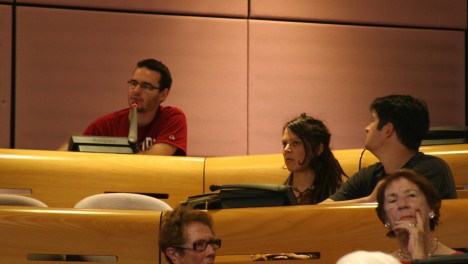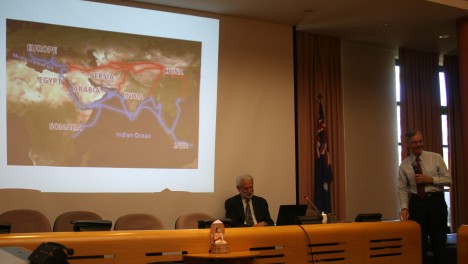Friday 26 April 2013, 1:00 pm – 2:00 pm Free Seminar by Professor Lewis Lancaster
Is Buddhism a religion, a philosophy, or a cognitive science?
Venue: Conference Room (next to Main Shrine)
What role does Buddhism play in a global world of technology? In what ways has Buddhism become even more relevant today? With over fifty years of scholarship in Buddhist Studies, Professor Lancaster will explore the very nature of Buddhism itself. This exposition will uncover the “essence” behind tenets, philosophies, and the nature of perception. This lecture promises to be a journey exploring what makes Buddhism a growing and relevant religion in the world.
Saturday 27 April 2013, 10:00 am – 11:00 am Free Seminar by Professor Lewis Lancaster
Seaport Buddhism: International Maritime Trade and Religious Expansion
Venue: Conference Room (next to Main Shrine)
The Silk Road remains one of the most important processes by which Buddhism spread across Eurasia. There is now a growing awareness of the maritime contribution to the global network of trade and cultural diffusion. Professor Lewis Lancaster has made significant inroads in this field of study. By building a global team of researchers, utilizing new data collection technologies, and using advanced data mapping and visualization to integrate cutting-edge results about the movements and trails of bygone ships and sailors, Professor Lancaster will unveil the latest findings regarding mercantile activity and the spread of Buddhism.
Poster for Seminars by Professor Lancaster in April 2013
Summary
FIRST SEMINAR
“Is Buddhism a religion, a philosophy, or a cognitive science?”
Starting with the original definition of religion being the “state of life bound by monastic vows,” Professor Lancaster revealed that Buddhism was an earlier religion than the Abrahamic traditions. From this starting point, he argued how Buddhism demonstrated its religious elements through rituals, images and communities. As a philosophy, Buddhism appeals to those who love wisdom. From the Heart Sūtra, the succinct “form then is emptiness and emptiness is then form”, has provided fertile ground for centuries of philosophical discussions. Finally, Professor Lancaster showed how the corpus of Buddhist texts included perception and conceptualisation in most expositions. Buddhism helps us “see” the world as it really is, examining various means of knowledge as cognitive science does. Interspersed throughout his presentation, Professor Lancaster shared his experience in looking beyond the obvious. For example, by removing the layer of the most dominant religion in the United States i.e. Christianity, researchers found Buddhism to be the second religion in the west coast, Judaism in the east coast and Islam in most of the hinterland. This seminar provides many thought-provoking insights to help the audience understand how Buddhism continues to be a growing and relevant religion in the world.
SECOND SEMINAR
“Seaport Buddhism: International Maritime Trade and Religious Expansion.”
The Silk Road was one of the most important pathways through which Buddhism spread across Eurasia. In this stimulating seminar, Professor Lancaster showed how the overland Silk Road was a romantic misnomer and that maritime trade was equally if not more influential. That the Silk Road was a misnomer came from the discovery of India providing the major goods on the Silk Road and not China. The most popular overland Silk Road trade involved lighter Indian spices. In addition, there was a Great Circle linking both the land and sea “Silk Roads.” Pilgrim records showed the existence of such a Great Circle. By studying archaeological records through a global team of researchers utilising new data collection technologies and advanced data mapping and visualisation tools, Professor Lancaster showed how Buddhism was a mercantile religion. Seaports in the Indian subcontinent indicated the dominance of Avalokiteśvara Bodhisattva. Integrating cutting-edge results about the movements and trails of bygone ships and sailors, Professor Lancaster challenged our understanding of the spread of Buddhism via overland Silk Road and answered how Mahāyana Buddhism was a network that had both the northwest and southeast India at both ends. He reminded the audience that maritime merchants were critical in the establishment of the bhikkhunī order in China. He also explained how Buddhism went east more successfully than west through a systematic analysis of maritime trade patterns. Professor Lancaster has convincingly proven that seaport Buddhism was a topic not to be ignored.
Over eighty people participated in each seminar. Among the audience were faculty members from Health Sciences, Psychology, Religious Studies, Cultural Studies and a wide variety of other disciplines. The Q&A sessions on both occasions benefited from informed Buddhists and monastics from different traditions.
Jue Wei 1 May 2013
Last edited on November 17, 2013






























Hi. Do we need to register to attend the seminars? Thank you.
There is no need to register for the seminars.
Hi. Will the lecture be recorded and available online?
Pingback: Seminars in April 2013 by Professor Lewis Lancaster | Buddha's Birthday Education Project
Pingback: Pictures from Professor Lancaster Seminars | Buddha's Birthday Education Project
hi,
I click the link to slide and audio and it showed “The requested page “/download/lancaster/lancaster26.pdf” could not be found.”
I removed the link. I am not sure what happened to the slides.